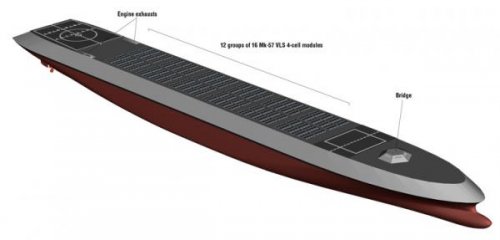"Breaking the Anti-Access Wall"
by Captain Sam J Tangredi, United States Navy (Ret.)
Proceedings May 2015
Source:
http://www.usni.org/magazines/proceedings/2015-05/breaking-anti-access-wall
EXCERPTS
Go to the link above to read the complete article.

by Captain Sam J Tangredi, United States Navy (Ret.)
Proceedings May 2015
Source:
http://www.usni.org/magazines/proceedings/2015-05/breaking-anti-access-wall
EXCERPTS
Go to the link above to read the complete article.
In this artist’s concept, the arsenal ship’s upper hull features stealth technology, while the lower hull, of traditional hydrodynamic design construction and form, would typically cruise at a lower waterline for relatively high-speed transit. In combat the ship would be ballasted down to the higher waterline, presenting only its stealth surfaces to enemy sensors and a much smaller profile.
NOTIONAL DESIGN
The best design for a ship that can provide the volume of ordnance required follows Metcalf’s initial inclinations. To describe it as “spartan” should be an understatement. A long series of VLSs encased in a largely submerged hull would be optimal.
For the purpose of reducing its radar signature, the ship’s freeboard should be as low as possible and not have a substantial superstructure—think of an iceberg with its top flattened. The most efficient method of doing this is by having the capability of ballasting down, similar to that of amphibious warships. With ballast tanks, voids, and fuel tanks along its underwater hull, and an internal double hull, a modicum of protection might be achieved against torpedoes and mines. However, its primary protection should be a large inventory of surface and underwater decoys, chaff launchers, jammers, and overall physical and electronic deception systems. Short-range point-defense systems against cruise missiles or aircraft could be installed, but with decks nearly awash, its most vulnerable exposure—like that of an armored tank—would be to plunging fire, not so easy to achieve with cruise missiles as might be commonly perceived. There could be three alternative—or combined—methods of targeting the arsenal ship’s ordnance. It could receive an ever-updating target set from a real-time satellite downlink or other Fleet network; it could fire its missiles at already preprogrammed targets relying on terrain mapping or GPS; and/or it could simply fire its ordnance to be controlled by another ship, an airborne controller, or be targeted by the force commander. (If preprogrammed for fixed targets, mobile targets would be the focus of other joint-strike assets.)
In any event, it should have an alternate target set already programmed so that if the arsenal ship took a severe hit, the entire inventory could be ripple fired to some meaningful effect before the ship became mission-incapable. The arsenal ship’s damage-control suite should be fully automated. The crew would be expected to conduct damage control only to the point of ensuring as many missiles as possible were launched. Similarly, the crew would be expected to perform only routine maintenance under way. In the event of a fatal hit, the arsenal ship’s minimally sized crew, perhaps less than ten sailors, would be provided with escape pods.
To reduce electronic detection, it should be a recipient—not a full participant—in Fleet network links. With no long-range sensors, it would not have any information to contribute to the net, except for when/where the missiles were launched. Once the missiles were launched, they would be completely autonomous of the arsenal ship itself. This would minimize electronic transmissions from the ship, thereby reducing the possibility of detection. The arsenal ship would be optimized so that the enemy could not hit the archer—or, at least, not until the quiver is empty.


